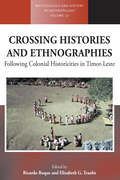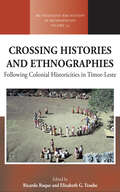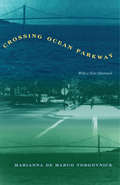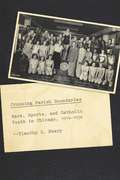- Table View
- List View
Crossing Borders and Shifting Boundaries: Vol. II: Gender, Identities and Networks (Schriftenreihe der internationalen Frauenuniversität "Technik und Kultur" #11)
by HelenSchwenken ClaudiaSchöning-Kalender MirjanaMorokvasic HelmaLutz IlseLenzThis volume introduces a gender dimension and provides new insights in the issues like nationalism and racism, identity building, transnational networking, citizenship and democracy.
Crossing Boundaries during Peace and Conflict: Transforming identity in Chiapas and in Northern Ireland (The Politics of Intersectionality)
by M. HoewerThe book takes the reader into the world of women who become actively involved in various mobilization processes in the peace and conflict situations in Chiapas and in Northern Ireland. Detailing how women cross identity boundaries in regions of conflict, the book combines traditional and qualitative research methods in groundbreaking new research.
Crossing Broadway: Washington Heights and the Promise of New York City
by Robert W. SnyderRobert W. Snyder's Crossing Broadway tells how disparate groups overcame their mutual suspicions to rehabilitate housing, build new schools, restore parks, and work with the police to bring safety to streets racked by crime and fear. It shows how a neighborhood once nicknamed "Frankfurt on the Hudson" for its large population of German Jews became "Quisqueya Heights"—the home of the nation's largest Dominican community.The story of Washington Heights illuminates New York City's long passage from the Great Depression and World War II through the urban crisis to the globalization and economic inequality of the twenty-first century. Washington Heights residents played crucial roles in saving their neighborhood, but its future as a home for working-class and middle-class people is by no means assured. The growing gap between rich and poor in contemporary New York puts new pressure on the Heights as more affluent newcomers move into buildings that once sustained generations of wage earners and the owners of small businesses.Crossing Broadway is based on historical research, reporting, and oral histories. Its narrative is powered by the stories of real people whose lives illuminate what was won and lost in northern Manhattan's journey from the past to the present. A tribute to a great American neighborhood, this book shows how residents learned to cross Broadway—over the decades a boundary that has separated black and white, Jews and Irish, Dominican-born and American-born—and make common cause in pursuit of one of the most precious rights: the right to make a home and build a better life in New York City.
Crossing Cultural Borders: Education for Immigrant Families in America (Routledge Library Editions: Immigration and Migration #6)
by Concha Delgado-Gaitan Henry TruebaCrossing Cultural Borders (1991) examines the day-to-day interaction of immigrant children with adults, siblings and peers in the home, school and community at large as these families demonstrate their skill in using their culture to survive in a new society. Children of Mexican and Central American immigrant families in Secoya crossed a national border, and continue to cross linguistic, social and cultural borders that separate the home, school and outside world.
Crossing Cultural Borders: Education for Immigrant Families in America (Routledge Library Editions: Immigration and Migration #6)
by Concha Delgado-Gaitan Henry TruebaCrossing Cultural Borders (1991) examines the day-to-day interaction of immigrant children with adults, siblings and peers in the home, school and community at large as these families demonstrate their skill in using their culture to survive in a new society. Children of Mexican and Central American immigrant families in Secoya crossed a national border, and continue to cross linguistic, social and cultural borders that separate the home, school and outside world.
Crossing Fandoms: SuperWhoLock and the Contemporary Fan Audience
by Paul BoothThis book examines the fan-created combination of Doctor Who, Sherlock, and Supernatural as a uniquely digital fan experience, and as a metaphor for ongoing scholarship into contemporary fandom. What do you get when you cross the cult shows Doctor Who, Supernatural, and Sherlock? In this book, Paul Booth explores the fan-created crossover universe known as SuperWhoLock—a universe where Sherlock Holmes and Dean Winchester work together to fight monsters like the Daleks and the Weeping Angels; a world where John Watson is friends with Amy Pond; a space where the unique brands of fandom interact. Booth argues that SuperWhoLock represents more than just those three shows—it is a way of doing fandom. Through interviews with fans and analysis of fan texts, Crossing Fandoms: SuperWhoLock and the Contemporary Fan Audience also demonstrates how fan studies in the digital age can evolve to take into account changing fan activities and texts.
Crossing Histories and Ethnographies: Following Colonial Historicities in Timor-Leste (Methodology & History in Anthropology #37)
by Ricardo Roque and Elizabeth G. TraubeThe key question for many anthropologists and historians today is not whether to cross the boundary between their disciplines, but whether the idea of a disciplinary boundary should be sustained. Reinterpreting the dynamic interplay between archive and field, these essays propose a method for mutually productive crossings between historical and ethnographic research. It engages critically with the colonial pasts of indigenous societies and examines how fieldwork and archival studies together lead to fruitful insights into the making of different colonial historicities. Timor-Leste’s unusually long and in some ways unique colonial history is explored as a compelling case for these crossings.
Crossing Histories and Ethnographies: Following Colonial Historicities in Timor-Leste (Methodology & History in Anthropology #37)
by Ricardo Roque and Elizabeth G. TraubeThe key question for many anthropologists and historians today is not whether to cross the boundary between their disciplines, but whether the idea of a disciplinary boundary should be sustained. Reinterpreting the dynamic interplay between archive and field, these essays propose a method for mutually productive crossings between historical and ethnographic research. It engages critically with the colonial pasts of indigenous societies and examines how fieldwork and archival studies together lead to fruitful insights into the making of different colonial historicities. Timor-Leste’s unusually long and in some ways unique colonial history is explored as a compelling case for these crossings.
Crossing Histories and Ethnographies: Following Colonial Historicities in Timor-Leste (Methodology & History in Anthropology #37)
by Ricardo Roque Elizabeth G. TraubeThe key question for many anthropologists and historians today is not whether to cross the boundary between their disciplines, but whether the idea of a disciplinary boundary should be sustained. Reinterpreting the dynamic interplay between archive and field, these essays propose a method for mutually productive crossings between historical and ethnographic research. It engages critically with the colonial pasts of indigenous societies and examines how fieldwork and archival studies together lead to fruitful insights into the making of different colonial historicities. Timor-Leste’s unusually long and in some ways unique colonial history is explored as a compelling case for these crossings.
Crossing Histories and Ethnographies: Following Colonial Historicities in Timor-Leste (Methodology & History in Anthropology #37)
by Ricardo Roque Elizabeth G. TraubeThe key question for many anthropologists and historians today is not whether to cross the boundary between their disciplines, but whether the idea of a disciplinary boundary should be sustained. Reinterpreting the dynamic interplay between archive and field, these essays propose a method for mutually productive crossings between historical and ethnographic research. It engages critically with the colonial pasts of indigenous societies and examines how fieldwork and archival studies together lead to fruitful insights into the making of different colonial historicities. Timor-Leste’s unusually long and in some ways unique colonial history is explored as a compelling case for these crossings.
Crossing Ocean Parkway
by Marianna De TorgovnickGrowing up an Italian-American in the Bensonhurst neighborhood of New York city, Marianna De Marco longed for college, culture, and upward mobility. Her daydreams circled around WASP (White Anglo Saxon Protestant) heroes on television—like Robin Hood and the Cartwright family—but in Brooklyn she never encountered any. So she associated moving up with Ocean Parkway, a street that divides the working-class Italian neighborhood where she was born from the middle-class Jewish neighborhood into which she married. This book is Torgovnick's unflinching account of crossing cultural boundaries in American life, of what it means to be an Italian American woman who became a scholar and literary critic. Included are autobiographical moments interwoven with engrossing interpretations of American cultural icons from Dr. Dolittle to Lionel Trilling, The Godfather to Camille Paglia. Her experiences allow her to probe the cultural tensions in America caused by competing ideas of individuality and community, upward mobility and ethnic loyalty, acquisitiveness and spirituality.
Crossing Ocean Parkway
by Marianna De TorgovnickGrowing up an Italian-American in the Bensonhurst neighborhood of New York city, Marianna De Marco longed for college, culture, and upward mobility. Her daydreams circled around WASP (White Anglo Saxon Protestant) heroes on television—like Robin Hood and the Cartwright family—but in Brooklyn she never encountered any. So she associated moving up with Ocean Parkway, a street that divides the working-class Italian neighborhood where she was born from the middle-class Jewish neighborhood into which she married. This book is Torgovnick's unflinching account of crossing cultural boundaries in American life, of what it means to be an Italian American woman who became a scholar and literary critic. Included are autobiographical moments interwoven with engrossing interpretations of American cultural icons from Dr. Dolittle to Lionel Trilling, The Godfather to Camille Paglia. Her experiences allow her to probe the cultural tensions in America caused by competing ideas of individuality and community, upward mobility and ethnic loyalty, acquisitiveness and spirituality.
Crossing Ocean Parkway
by Marianna De TorgovnickGrowing up an Italian-American in the Bensonhurst neighborhood of New York city, Marianna De Marco longed for college, culture, and upward mobility. Her daydreams circled around WASP (White Anglo Saxon Protestant) heroes on television—like Robin Hood and the Cartwright family—but in Brooklyn she never encountered any. So she associated moving up with Ocean Parkway, a street that divides the working-class Italian neighborhood where she was born from the middle-class Jewish neighborhood into which she married. This book is Torgovnick's unflinching account of crossing cultural boundaries in American life, of what it means to be an Italian American woman who became a scholar and literary critic. Included are autobiographical moments interwoven with engrossing interpretations of American cultural icons from Dr. Dolittle to Lionel Trilling, The Godfather to Camille Paglia. Her experiences allow her to probe the cultural tensions in America caused by competing ideas of individuality and community, upward mobility and ethnic loyalty, acquisitiveness and spirituality.
Crossing Ocean Parkway
by Marianna De TorgovnickGrowing up an Italian-American in the Bensonhurst neighborhood of New York city, Marianna De Marco longed for college, culture, and upward mobility. Her daydreams circled around WASP (White Anglo Saxon Protestant) heroes on television—like Robin Hood and the Cartwright family—but in Brooklyn she never encountered any. So she associated moving up with Ocean Parkway, a street that divides the working-class Italian neighborhood where she was born from the middle-class Jewish neighborhood into which she married. This book is Torgovnick's unflinching account of crossing cultural boundaries in American life, of what it means to be an Italian American woman who became a scholar and literary critic. Included are autobiographical moments interwoven with engrossing interpretations of American cultural icons from Dr. Dolittle to Lionel Trilling, The Godfather to Camille Paglia. Her experiences allow her to probe the cultural tensions in America caused by competing ideas of individuality and community, upward mobility and ethnic loyalty, acquisitiveness and spirituality.
Crossing Ocean Parkway
by Marianna De TorgovnickGrowing up an Italian-American in the Bensonhurst neighborhood of New York city, Marianna De Marco longed for college, culture, and upward mobility. Her daydreams circled around WASP (White Anglo Saxon Protestant) heroes on television—like Robin Hood and the Cartwright family—but in Brooklyn she never encountered any. So she associated moving up with Ocean Parkway, a street that divides the working-class Italian neighborhood where she was born from the middle-class Jewish neighborhood into which she married. This book is Torgovnick's unflinching account of crossing cultural boundaries in American life, of what it means to be an Italian American woman who became a scholar and literary critic. Included are autobiographical moments interwoven with engrossing interpretations of American cultural icons from Dr. Dolittle to Lionel Trilling, The Godfather to Camille Paglia. Her experiences allow her to probe the cultural tensions in America caused by competing ideas of individuality and community, upward mobility and ethnic loyalty, acquisitiveness and spirituality.
Crossing Ocean Parkway
by Marianna De TorgovnickGrowing up an Italian-American in the Bensonhurst neighborhood of New York city, Marianna De Marco longed for college, culture, and upward mobility. Her daydreams circled around WASP (White Anglo Saxon Protestant) heroes on television—like Robin Hood and the Cartwright family—but in Brooklyn she never encountered any. So she associated moving up with Ocean Parkway, a street that divides the working-class Italian neighborhood where she was born from the middle-class Jewish neighborhood into which she married. This book is Torgovnick's unflinching account of crossing cultural boundaries in American life, of what it means to be an Italian American woman who became a scholar and literary critic. Included are autobiographical moments interwoven with engrossing interpretations of American cultural icons from Dr. Dolittle to Lionel Trilling, The Godfather to Camille Paglia. Her experiences allow her to probe the cultural tensions in America caused by competing ideas of individuality and community, upward mobility and ethnic loyalty, acquisitiveness and spirituality.
Crossing Parish Boundaries: Race, Sports, and Catholic Youth in Chicago, 1914-1954 (Historical Studies of Urban America)
by Timothy B. NearyControversy erupted in spring 2001 when Chicago’s mostly white Southside Catholic Conference youth sports league rejected the application of the predominantly black St. Sabina grade school. Fifty years after Brown v. Board of Education, interracialism seemed stubbornly unattainable, and the national spotlight once again turned to the history of racial conflict in Catholic parishes. It’s widely understood that midcentury, working class, white ethnic Catholics were among the most virulent racists, but, as Crossing Parish Boundaries shows, that’s not the whole story. In this book, Timothy B. Neary reveals the history of Bishop Bernard Sheil’s Catholic Youth Organization (CYO), which brought together thousands of young people of all races and religions from Chicago’s racially segregated neighborhoods to take part in sports and educational programming. Tens of thousands of boys and girls participated in basketball, track and field, and the most popular sport of all, boxing, which regularly filled Chicago Stadium with roaring crowds. The history of Bishop Sheil and the CYO shows a cosmopolitan version of American Catholicism, one that is usually overshadowed by accounts of white ethnic Catholics aggressively resisting the racial integration of their working-class neighborhoods. By telling the story of Catholic-sponsored interracial cooperation within Chicago, Crossing Parish Boundaries complicates our understanding of northern urban race relations in the mid-twentieth century.
Crossing Parish Boundaries: Race, Sports, and Catholic Youth in Chicago, 1914-1954 (Historical Studies of Urban America)
by Timothy B. NearyControversy erupted in spring 2001 when Chicago’s mostly white Southside Catholic Conference youth sports league rejected the application of the predominantly black St. Sabina grade school. Fifty years after Brown v. Board of Education, interracialism seemed stubbornly unattainable, and the national spotlight once again turned to the history of racial conflict in Catholic parishes. It’s widely understood that midcentury, working class, white ethnic Catholics were among the most virulent racists, but, as Crossing Parish Boundaries shows, that’s not the whole story. In this book, Timothy B. Neary reveals the history of Bishop Bernard Sheil’s Catholic Youth Organization (CYO), which brought together thousands of young people of all races and religions from Chicago’s racially segregated neighborhoods to take part in sports and educational programming. Tens of thousands of boys and girls participated in basketball, track and field, and the most popular sport of all, boxing, which regularly filled Chicago Stadium with roaring crowds. The history of Bishop Sheil and the CYO shows a cosmopolitan version of American Catholicism, one that is usually overshadowed by accounts of white ethnic Catholics aggressively resisting the racial integration of their working-class neighborhoods. By telling the story of Catholic-sponsored interracial cooperation within Chicago, Crossing Parish Boundaries complicates our understanding of northern urban race relations in the mid-twentieth century.
Crossing Parish Boundaries: Race, Sports, and Catholic Youth in Chicago, 1914-1954 (Historical Studies of Urban America)
by Timothy B. NearyControversy erupted in spring 2001 when Chicago’s mostly white Southside Catholic Conference youth sports league rejected the application of the predominantly black St. Sabina grade school. Fifty years after Brown v. Board of Education, interracialism seemed stubbornly unattainable, and the national spotlight once again turned to the history of racial conflict in Catholic parishes. It’s widely understood that midcentury, working class, white ethnic Catholics were among the most virulent racists, but, as Crossing Parish Boundaries shows, that’s not the whole story. In this book, Timothy B. Neary reveals the history of Bishop Bernard Sheil’s Catholic Youth Organization (CYO), which brought together thousands of young people of all races and religions from Chicago’s racially segregated neighborhoods to take part in sports and educational programming. Tens of thousands of boys and girls participated in basketball, track and field, and the most popular sport of all, boxing, which regularly filled Chicago Stadium with roaring crowds. The history of Bishop Sheil and the CYO shows a cosmopolitan version of American Catholicism, one that is usually overshadowed by accounts of white ethnic Catholics aggressively resisting the racial integration of their working-class neighborhoods. By telling the story of Catholic-sponsored interracial cooperation within Chicago, Crossing Parish Boundaries complicates our understanding of northern urban race relations in the mid-twentieth century.
Crossing Parish Boundaries: Race, Sports, and Catholic Youth in Chicago, 1914-1954 (Historical Studies of Urban America)
by Timothy B. NearyControversy erupted in spring 2001 when Chicago’s mostly white Southside Catholic Conference youth sports league rejected the application of the predominantly black St. Sabina grade school. Fifty years after Brown v. Board of Education, interracialism seemed stubbornly unattainable, and the national spotlight once again turned to the history of racial conflict in Catholic parishes. It’s widely understood that midcentury, working class, white ethnic Catholics were among the most virulent racists, but, as Crossing Parish Boundaries shows, that’s not the whole story. In this book, Timothy B. Neary reveals the history of Bishop Bernard Sheil’s Catholic Youth Organization (CYO), which brought together thousands of young people of all races and religions from Chicago’s racially segregated neighborhoods to take part in sports and educational programming. Tens of thousands of boys and girls participated in basketball, track and field, and the most popular sport of all, boxing, which regularly filled Chicago Stadium with roaring crowds. The history of Bishop Sheil and the CYO shows a cosmopolitan version of American Catholicism, one that is usually overshadowed by accounts of white ethnic Catholics aggressively resisting the racial integration of their working-class neighborhoods. By telling the story of Catholic-sponsored interracial cooperation within Chicago, Crossing Parish Boundaries complicates our understanding of northern urban race relations in the mid-twentieth century.
Crossing Parish Boundaries: Race, Sports, and Catholic Youth in Chicago, 1914-1954 (Historical Studies of Urban America)
by Timothy B. NearyControversy erupted in spring 2001 when Chicago’s mostly white Southside Catholic Conference youth sports league rejected the application of the predominantly black St. Sabina grade school. Fifty years after Brown v. Board of Education, interracialism seemed stubbornly unattainable, and the national spotlight once again turned to the history of racial conflict in Catholic parishes. It’s widely understood that midcentury, working class, white ethnic Catholics were among the most virulent racists, but, as Crossing Parish Boundaries shows, that’s not the whole story. In this book, Timothy B. Neary reveals the history of Bishop Bernard Sheil’s Catholic Youth Organization (CYO), which brought together thousands of young people of all races and religions from Chicago’s racially segregated neighborhoods to take part in sports and educational programming. Tens of thousands of boys and girls participated in basketball, track and field, and the most popular sport of all, boxing, which regularly filled Chicago Stadium with roaring crowds. The history of Bishop Sheil and the CYO shows a cosmopolitan version of American Catholicism, one that is usually overshadowed by accounts of white ethnic Catholics aggressively resisting the racial integration of their working-class neighborhoods. By telling the story of Catholic-sponsored interracial cooperation within Chicago, Crossing Parish Boundaries complicates our understanding of northern urban race relations in the mid-twentieth century.
Crossing Parish Boundaries: Race, Sports, and Catholic Youth in Chicago, 1914-1954 (Historical Studies of Urban America)
by Timothy B. NearyControversy erupted in spring 2001 when Chicago’s mostly white Southside Catholic Conference youth sports league rejected the application of the predominantly black St. Sabina grade school. Fifty years after Brown v. Board of Education, interracialism seemed stubbornly unattainable, and the national spotlight once again turned to the history of racial conflict in Catholic parishes. It’s widely understood that midcentury, working class, white ethnic Catholics were among the most virulent racists, but, as Crossing Parish Boundaries shows, that’s not the whole story. In this book, Timothy B. Neary reveals the history of Bishop Bernard Sheil’s Catholic Youth Organization (CYO), which brought together thousands of young people of all races and religions from Chicago’s racially segregated neighborhoods to take part in sports and educational programming. Tens of thousands of boys and girls participated in basketball, track and field, and the most popular sport of all, boxing, which regularly filled Chicago Stadium with roaring crowds. The history of Bishop Sheil and the CYO shows a cosmopolitan version of American Catholicism, one that is usually overshadowed by accounts of white ethnic Catholics aggressively resisting the racial integration of their working-class neighborhoods. By telling the story of Catholic-sponsored interracial cooperation within Chicago, Crossing Parish Boundaries complicates our understanding of northern urban race relations in the mid-twentieth century.
Crossing Sex and Gender in Latin America
by V. LewisSignifying "others" or signs of life? This book critically examines the ways in which crossing sex and gender is imagined in key cultural texts from contemporary Latin America. Unlike previous studies, Crossing Sex and Gender in Latin America does not hold that sexually diverse figures are always and only performative or allegorical and instead places the accent on questions of the presence or absence of an account of subjectivity in contemporary representation. Via analysis of selected films and literary works of Reinaldo Arenas, Mayra Santos-Febres, Pedro Lemebel, among others, the author reflects on the political implications of recent visions (1985-2005).
Crossing the Ethnic Divide: The Multiethnic Church on a Mission (AAR Academy Series)
by Kathleen Garces-FoleyWhile religious communities often stress the universal nature of their beliefs, it remains true that people choose to worship alongside those they identify with most easily. Multiethnic churches are rare in the United States, but as American attitudes toward diversity change, so too does the appeal of a church that offers diversity. Joining such a community, however, is uncomfortable-worshippers must literally cross the barriers of ethnic difference by entering the religious space of the ethnically "other." Through the story of one multiethnic congregation in Southern California, Kathleen Garces-Foley examines what it means to confront the challenges in forming a religious community across ethnic divisions and attracting a more varied membership.
Crossing the Ethnic Divide: The Multiethnic Church on a Mission (AAR Academy Series)
by Kathleen Garces-FoleyWhile religious communities often stress the universal nature of their beliefs, it remains true that people choose to worship alongside those they identify with most easily. Multiethnic churches are rare in the United States, but as American attitudes toward diversity change, so too does the appeal of a church that offers diversity. Joining such a community, however, is uncomfortable-worshippers must literally cross the barriers of ethnic difference by entering the religious space of the ethnically "other." Through the story of one multiethnic congregation in Southern California, Kathleen Garces-Foley examines what it means to confront the challenges in forming a religious community across ethnic divisions and attracting a more varied membership.










